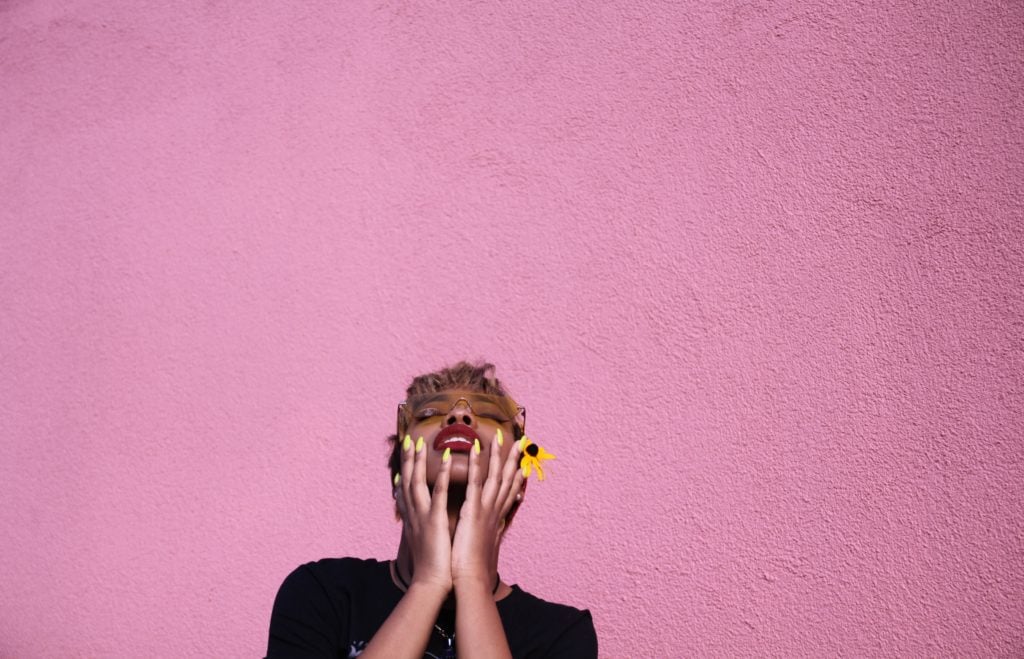
Fashionable person in front of a pink background. Their head is tilted up with their eyes closed and hands cupping their cheeks.
Recently, I bought a $5 pair of lilac suede heels that felt like my queerest wardrobe addition in a while. They were ridiculously handsome.
These heels were so alluring to me because they represented an evolution in my typical gender presentation. I normally wear some version of joggers, black boots, and a plain T-shirt, a combination that doesn’t really challenge me to reinvent myself on the daily.
But when I wear clothing or accessories that push my boundaries, I feel capable of embodying the expansiveness of gender and witnessing myself in all different forms.
To me, the vastness of gender is undeniable given the vastness of human expression, yet dominant narratives tend to constrict gender affirmation to being white, binarist, and thin.
I want to share four ways I’ve managed to affirm my gender through fashion in order to share my take on disrupting the contradictory, imaginary game of gender.
1. Taking creative approaches to style and shape.
I often choose to wear loose-fitting tops and skinnier bottoms because that’s what usually feels aesthetically fulfilling to me based on how the world reads me and also, how I perceive myself.
But even while I do feel safest wearing my “standard uniform,” I have a lot of fun mixing up the shapes and accessories that I incorporate into what I wear.
For example, instead of putting on a plain cotton T-shirt, I might choose to wear a silk band collar shirt or a puffy sleeve blouse with either studs or hanging earrings.
I’ve learned there is no shortage of stylistic experimentation that’s possible if we allow ourselves to exist outside of the gendered boxes that constrain how we express ourselves.
Try this exercise with your own wardrobe: Instead of thinking about which style choices confirm a stagnant idea of your identity (like tomboy or high femme), consider possibilities outside of that idea.
Erase gender constructs from your formula and imagine which shapes and styles you can play with to meet a different version of yourself — one that’s still you and can be any gender you want in any moment, even if the world thinks it’s impossible.
Not everyone can experiment with their look in public for security reasons, but it’s definitely still possible to dream up differently gendered styles and consider how it may feel to embody yourself in them in the future.
2. Playing with color or texture.
As I’ve already mentioned, style experimentation has a lot to do with creativity, and the good thing is, no particular skill is required. Experimenting can even awaken creative inclinations that you didn’t know existed!
Color and texture are important qualities of clothing and style. Unfortunately, both are often gendered, but neither need to be.
I’ve mostly felt comfortable wearing neutral colors, but in the past year, I’ve began to feel comfortable trying on different colors, like shades of pink, orange, and blue.
In the U.S. context I grew up in, neutral colors are most commonly associated with cisgender (cis) men and solemnity, but I’ve decided to break myself out from wearing only neutral hues because I find them as restricting as I do cis masculinity!
Textures also influence how you may perceive yourself and how the outside world may read you. I’ve chosen to stick to cottons and silks for most of my adult life, but I wonder what it would feel like if I threw on some linens, leather, or velvet!
3. Using my body as a canvas.
At the moment, I don’t have any ink tattoos, but I’ve used henna and body paint on myself to test out the ways color and shapes add to my personal style.
I’m interested in the ways that I can incorporate style into each layer of my expression, from my outside clothes to my underwear, all the way down to my skin.
The way I see it, my style shouldn’t only extend to how others perceive me — it should also stretch to the more intimate level of how I perceive myself.
The outside world has totally screwed up ideas about gender, so why should I perform all of my stylistic intentions and vulnerability for it?
4. Changing my form.
The three points I’ve listed thus far come from my perspective, which has formed from a combination of my experiences. For that reason, I don’t wish to create the impression that what works for me works for everybody else.
But the main message I’m looking to convey is that experimentation, to me, is more gender-affirming than striving for a static idea. This is due to the fact that I understand gender as a process of “doing” as opposed to a stagnant state of being.
This next point in particular is one that may not be fitting for everyone, but has helped me feel confident that I’m continuing to do and undo gender.
I’ve experienced a mixture of emotions as I’ve grown and cut my hair into different styles. Over the past year, I’ve had shoulder-length hair, hair that reaches my eyes, an undercut, an entirely shaved head, and a partially shaved head.
Each time I change my hairstyle, I notice different reactions from friends, family members, and the public. Their reactions teach me a lot about society and gender, as well as race and class expectations.
While it’s had this effect, it’s also given me the confidence to continue challenging norms and expectations.
Because I realize that, even if on one day I’m passing as a non-threatening presence to society’s standards around gender or other identities, the same people who aren’t threatened by me that day are still the people who will make me feel uncomfortable if I present as a different version of myself tomorrow.
***
For me, gender affirmation isn’t as much about consistently associating myself within a toxic gender system, but it’s about doing what I can to be safe from the system on some days, while being safe enough to challenge it on others.
[do_widget id=’text-101′]
Ayesha Sharma is a non-binary South Asian scholar and artist continually negotiating a relationship with themselves and their communities through practices of decolonization. They are most interested in literal and symbolic reclamation as an art practice, and investing themselves in community care. Ayesha has written for the Urban Democracy Lab and is published in ANTYAJAA: Indian Journal of Women and Social Change.
Search our 3000+ articles!
Read our articles about:
Our online racial justice training
Used by hundreds of universities, non-profits, and businesses.
Click to learn more




















